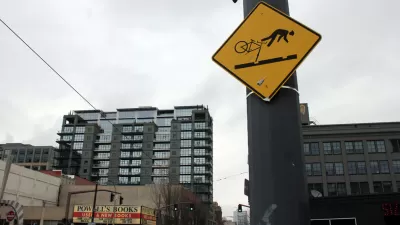Time will tell whether President Trump is able to enact any of the ambitious trade policies he proposed on the campaign trail, but research shows the cities that will prosper or suffer based on the success of those initiatives.

Ana Swanson, Ted Mellnik, and Darla Cameron report on the potential impacts on local and regional communities should President Trump achieve his policy agenda on matters of trade—"sweeping measures"
such as "writing the free-trade agreement with Canada and Mexico, or new taxes to make imports more expensive and boost competing American goods."
The article shares research by the Brookings Institution's Metropolitan Policy Program, presented visually in a map that illustrates the places in the United States "most exposed in a trade war." The map shows how dependent counties are on trade, by measuring how large a portion of the local economy is devoted to exports and how many jobs directly relate to export activity.
"While exposure to trade differs substantially across the country, every U.S. metro area has some exposure, with at least $1 out of every $20 generated in the local economy coming from exports. Most cities get much more. That means these cities have a lot to gain as well as potentially lose from major changes to trade policy," write the trio of reporters in sharing the findings of the Brookings analysis.
Interestingly, the city with the largest share of GDP devoted to exports is Columbus, Indiana, "the home base for engine-maker Cummins Inc. and other automotive manufacturers, and the hometown of Vice President Pence." That example fits a common theme in the data: counties that voted for Trump in the 2016 president election tend to have economies more devoted to exports. "According to Brookings estimates, exports make up 13 percent of local GDP in counties won by Trump, compared to 10 percent in counties won by Clinton," states the article.
FULL STORY: The places in America most exposed to a trade war

Planetizen Federal Action Tracker
A weekly monitor of how Trump’s orders and actions are impacting planners and planning in America.

Restaurant Patios Were a Pandemic Win — Why Were They so Hard to Keep?
Social distancing requirements and changes in travel patterns prompted cities to pilot new uses for street and sidewalk space. Then it got complicated.

Map: Where Senate Republicans Want to Sell Your Public Lands
For public land advocates, the Senate Republicans’ proposal to sell millions of acres of public land in the West is “the biggest fight of their careers.”

Maui's Vacation Rental Debate Turns Ugly
Verbal attacks, misinformation campaigns and fistfights plague a high-stakes debate to convert thousands of vacation rentals into long-term housing.

San Francisco Suspends Traffic Calming Amidst Record Deaths
Citing “a challenging fiscal landscape,” the city will cease the program on the heels of 42 traffic deaths, including 24 pedestrians.

California Homeless Arrests, Citations Spike After Ruling
An investigation reveals that anti-homeless actions increased up to 500% after Grants Pass v. Johnson — even in cities claiming no policy change.
Urban Design for Planners 1: Software Tools
This six-course series explores essential urban design concepts using open source software and equips planners with the tools they need to participate fully in the urban design process.
Planning for Universal Design
Learn the tools for implementing Universal Design in planning regulations.
Heyer Gruel & Associates PA
JM Goldson LLC
Custer County Colorado
City of Camden Redevelopment Agency
City of Astoria
Transportation Research & Education Center (TREC) at Portland State University
Camden Redevelopment Agency
City of Claremont
Municipality of Princeton (NJ)




























